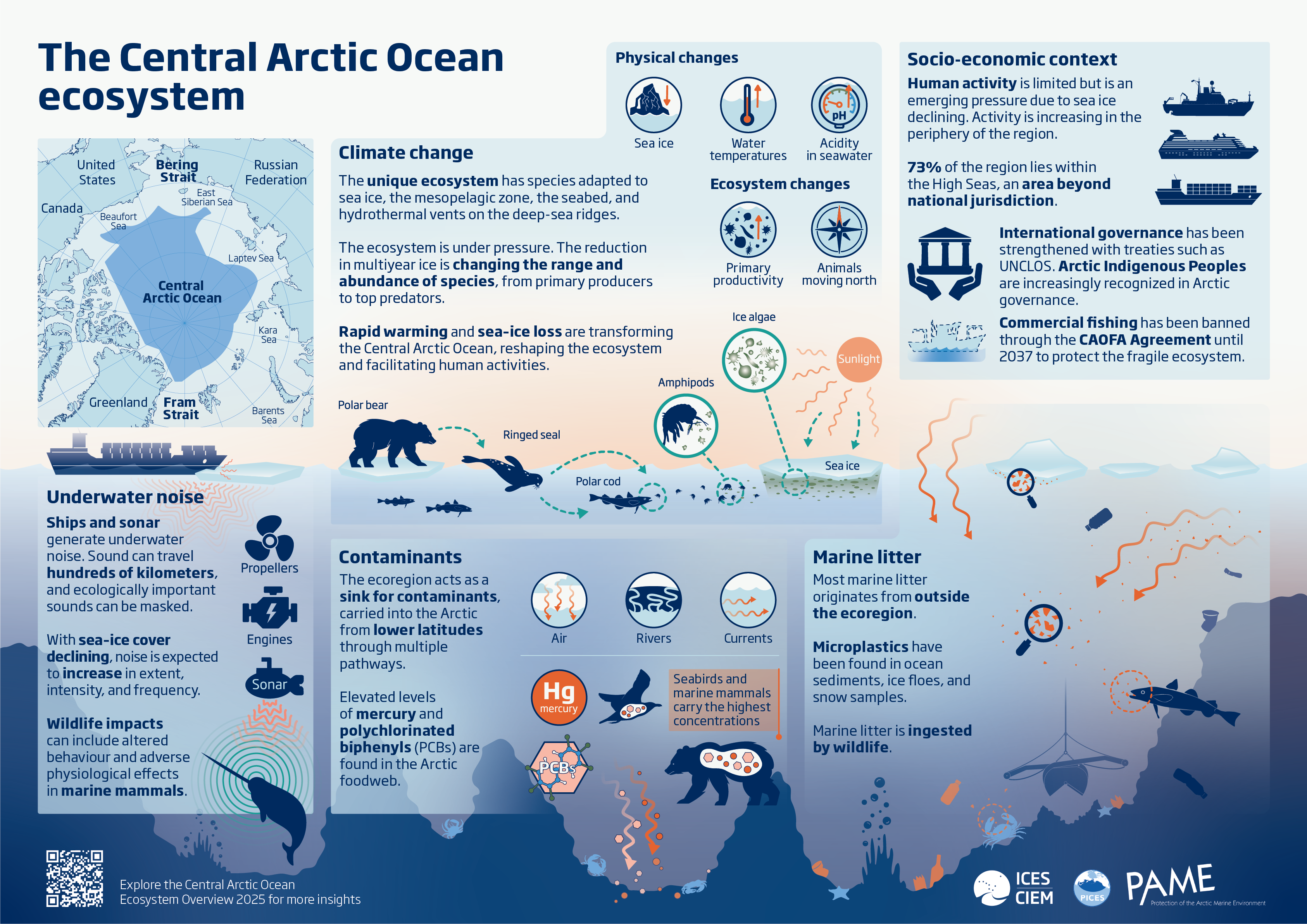As the Arctic warms faster than any other region on Earth, understanding its fragile ecosystems has never been more urgent. This year marks the tenth anniversary of the Working Group on the Integrated Ecosystem Assessment of the Central Arctic Ocean (WGICA), a broad international collaboration that brings together scientists, knowledge, and results from working groups of the North Atlantic (ICES), North Pacific (PICES), and the Arctic Council (PAME, CAFF, and AMAP). WGICA's mission is to study and understand the changing Central Arctic Ocean (CAO) ecosystem, from the Pacific Bering Strait, across the Central Arctic Ocean, and to the Atlantic Fram Strait.
Meeting this week at the PICES Annual Meeting in Yokohama, Japan, WGICA celebrates a decade of collaboration with the release of two new publications:
While the biology and physical features of this unique ecosystem were the focus of WGICA's first CAO Ecosystem Overview and Part 1 of the CRR (CRR 355), published in 2021 and 2022, these new outputs turn the spotlight on human activities. They assess how shipping, tourism, research, and global pollution are shaping the Arctic environment and highlight how these pressures interact with the accelerating effects of climate change.
Mapping pressures in a rapidly changing Arctic
The CAO plays a crucial role in global ocean circulation and climate regulation, but remains one of the least accessible and least understood marine ecosystems.
The newly published Ecosystem Overview and CRR 361 reveal that climate change continues to be the dominant force shaping the Central Arctic Ocean, with the rapid loss of sea ice transforming habitats and altering the distribution of species. As the ice retreats, human activities are expanding northward, bringing new challenges such as underwater noise, contamination, and physical disturbance to this fragile ecosystem.
Climate change and human activities
Despite its remote location and sparse number of human activities, the CAO serves as a sink for global pollutants, which accumulate through the food web and reach particularly high concentrations in ice-associated predators, including seabirds and polar bears. The overview also highlights that climate change is affecting contaminant pathways and loading in the ecoregion.
Biota in the ecoregion are unique, with sea ice providing habitats for ice-associated species, and deep-sea abyssal plains and mountain ridges hosting species fully adapted to their specific environmental conditions. Atlantic and Pacific marine species are extending their distributions northwards, changing the species composition in the ecoregion.
These findings provide essential input for the Central Arctic Ocean Fisheries Agreement (CAOFA) and guide ecosystem-based management of this increasingly accessible and vulnerable region.
A model for scientific cooperation
WGICA demonstrates how international collaboration can overcome political and logistical barriers to advance science in one of the world's most challenging regions. Supported by ICES, PICES, and PAME, WGICA's achievements demonstrate the power of collective, evidence-based effort in support of sustainable Arctic governance.
At its tenth anniversary, WGICA is now looking ahead by developing future objectives that may lead to expanding partnerships with stakeholders to continue building the knowledge base for a sustainable Arctic.
International cooperation is crucial
"The next WGICA period will focus on five major topics for the Central Arctic Ocean", says Martine van den Heuvel-Greve, WGICA co-chair, “Future climate scenarios, Commercial species, Vulnerability and fragility, Exploratory fishery, and Human activities and cumulative effects".
Lis Lindal Jørgensen, WGICA co-chair, adds, "We will do this by involving other institutions such as the Conservation of Arctic Flora and Fauna (CAFF), Arctic Monitoring and Assessment Programme (AMAP), OSPAR Commission, North-East Atlantic Fisheries Commission (NEAFC), and Central Arctic Ocean Fisheries Agreement (CAOFA), and asking them how we can collaborate and align our research efforts to create synergy rather than redundancy. The Inuit Circumpolar Council (ICC) were also clear that inclusion of Indigenous voices was obligatory."
"As WGICA, we need to develop solutions for all these collaborative efforts", says van den Heuvel-Greve, "and this marks the beginning of that process, here in Yokohama".

Click the infographic to view full screen.
View and download the Central Arctic Ocean Ecosystem Overview along with CRR No. 361 – Ecosystem assessment of the Central Arctic Ocean, Part 2: Human activities, pressures, and vulnerability of the ecosystem from our online library.

